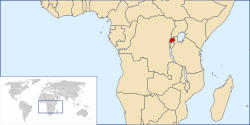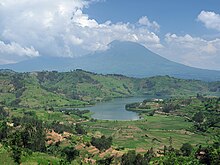Rwanda
Republic of Rwanda Repubulika y'u Rwanda République du Rwanda | |
|---|---|
Motto:
| |
| Anthem: "Rwanda Nziza" (English: "Beautiful Rwanda") | |
 | |
| Capital and largest city | Kigali 1°56′38″S 30°3′34″E / 1.94389°S 30.05944°E |
| Official languages | Kinyarwanda English |
| Recognised national languages | Swahili |
| Ethnic groups |
|
| Demonym(s) | Rwandan, Rwandese |
| Government | Unitary parliamentary democracy and Presidential republic |
| Paul Kagame | |
| Édouard Ngirente | |
| Independence | |
• from Belgium | 1 July 1962 |
| Area | |
• Total | 26,338 km2 (10,169 sq mi) (144th) |
• Water (%) | 5.3 |
| Population | |
• 2012 estimate | 11,689,696[1] (73rd) |
• 2002 census | 8,162,715[2] |
• Density | 419.8/km2 (1,087.3/sq mi) (29th) |
| GDP (PPP) | 2011 estimate |
• Total | $13.109 billion[3] |
• Per capita | $1,284[3] |
| GDP (nominal) | 2011 estimate |
• Total | $6.055 billion[3] |
• Per capita | $593[3] |
| HDI (2018) | low · 157th |
| Currency | Rwandan franc (RWF) |
| Time zone | UTC+2 (CAT) |
• Summer (DST) | UTC+2 (not observed) |
| Driving side | right |
| Calling code | 250 |
| ISO 3166 code | RW |
| Internet TLD | .rw |

Rwanda is a country in Africa. It is near Burundi, Congo-Kinshasa, Uganda, and Tanzania. In the Rwandan genocide of 1994, over one million (1,000,000) people were killed.
History
[change | change source]Colonialism
[change | change source]During the Scramble for Africa, Belgium conquered Rwanda. The Belgians then began to divide Rwandans into groups: Hutu, and Tutsi. The Belgians picked people that they thought looked more European to be Tutsi. The rest became Hutu. The Belgians told Rwandans that Tutsi were superior to Hutu. They helped Tutsi rule over Hutu using their army.[5]
After independence
[change | change source]On July 1, 1962, Rwanda became independent and Hutu were given power. Thus, anti-Tutsi purges occurred frequently. Many Tutsi fled to Uganda, where they formed the Rwandan Patriotic Front, or RPF, which tried to invade Rwanda in 1990.
The genocide against Tutsi
[change | change source]On the night of April 6, 1994, dictator Juvénal Habyarimana's plane was shot down, but it is still not clear who did it. Within half an hour, roadblocks manned by the Interahamwe militia were seen all over the capital, Kigali. The genocide against Tutsi had begun. It lasted for about 100 days, and it left over one million (1,000,000), Tutsi and moderate Hutu dead. The main weapon used was the machete, or umupanga. Other countries paid little attention to the killing. On July 2, 1994, the RPF captured Kigali.[6]
Geography
[change | change source]
At 26,338 square kilometres (10,169 sq mi), Rwanda is the world's 149th-largest country. The entire country is at a high altitude. The lowest point is the Rusizi River (also sometimes spelled Ruzizi) at 950 metres (3,117 ft) above sea level. Rwanda is in Central/Eastern Africa. It is bordered by the Democratic Republic of the Congo to the west, Uganda to the north, Tanzania to the east, and Burundi to the south. It is a few degrees south of the equator and is landlocked. The capital, Kigali, is near the centre of Rwanda.
The country's longest river is the Nyabarongo. The Nyabarongo-Kagera eventually drains into Lake Victoria. Rwanda has many lakes, the largest being Lake Kivu. It is one of the twenty deepest lakes in the world. Other sizeable lakes include Burera, Ruhondo, Muhazi, Rweru, and Ihema. Ihema is the largest of a string of lakes in the eastern plains of Akagera National Park.

There are many mountains in central and western Rwanda. The highest peaks are found in the Virunga volcano chain in the northwest. This includes Mount Karisimbi, Rwanda's highest point, at 4,507 metres (14,787 ft). The centre of the country is mostly rolling hills. The eastern border area has savanna, plains and swamps.
Rwanda has a temperate tropical highland climate. It has lower temperatures than are typical for equatorial countries. This is because of its high elevation. Kigali, in the centre of the country, has a typical daily temperature range between 12 °C (54 °F) and 27 °C (81 °F). There is little change through the year. There are two rainy seasons in the year. The first runs from February to June and the second from September to December. These are separated by two dry seasons. The major one is from June to September, during which there is often no rain at all. There is a shorter and less severe one from December to February.
Biodiversity
[change | change source]
In prehistoric times montane forest covered one third of the land of present-day Rwanda. Naturally occurring vegetation is now mostly in the three National parks, with terraced agriculture in the rest of the country. Nyungwe, the largest remaining forest, has 200 species of tree as well as orchids and begonias. Vegetation in the Volcanoes National Park is mostly bamboo and moorland, with small areas of forest. Akagera has a savanna ecosystem. Here there are mostly acacia. There are several rare or endangered plant species in Akagera, including Markhamia lutea and Eulophia guineensis.
The greatest diversity of large mammals is found in the three National Parks. Akagera has typical savanna animals such as giraffes and elephants, while Volcanoes is home to about one third of the worldwide mountain gorilla population. Nyungwe Forest has thirteen primate species including chimpanzees and Colobus monkeys. The Ruwenzori colobus move in groups of up to 400, the largest troop size of any primate in Africa.
There are 670 bird species in Rwanda. There is a difference between the east and the west. Nyungwe Forest, in the west, has 280 recorded species. Species include the Ruwenzori Turaco and Handsome Francolin. Eastern Rwanda, by contrast, has savanna birds such as the Black-headed Gonolek and those who live near swamps and lakes, including storks and cranes.
Related pages
[change | change source]References
[change | change source]- ↑ CIA (IV) 2012.
- ↑ National Census Service 2003, p. 16.
- ↑ 3.0 3.1 3.2 3.3 IMF (II).
- ↑ "Human Development Report 2019". United Nations Development Programme. 10 December 2019. Archived from the original (PDF) on 23 May 2020. Retrieved 10 December 2019.
- ↑ Steven Skok. "What Impact Did the Belgian Presence in Rwanda Have to Spark Further Conflict?". Education - Seattle PI. Retrieved 2020-10-24.
Allowing the existing Tutsi monarchs to exhibit control over the Hutu proved immediately effective, allowing for colonization without a large force of European troops. The Belgians further exploited the Tutsi-Hutu division, lending military and political support to Tutsi leaders who maintained the policies of their colonial rulers.
- ↑ "Education – Kigali Genocide Memorial". Archived from the original on 2020-02-13. Retrieved 2020-02-22.
Other websites
[change | change source]- The Republic of Rwanda (official government site)
- Rwanda Tourism (official Rwanda Tourism Board site)




